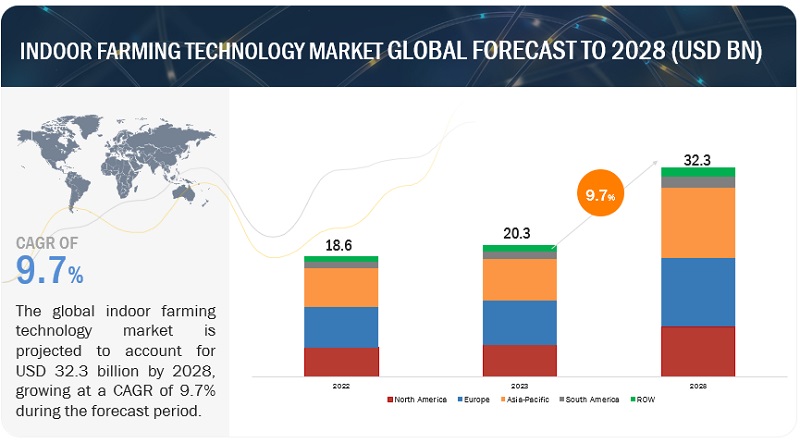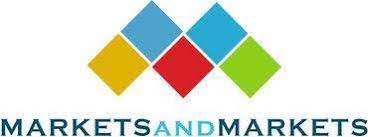Indoor Farming Technology Market Size, Share, Growth Drivers, Industry Overview, Trends, Leading Players, and Forecast (2023-2028)
The indoor farming technology market size is expected to grow at a compound annual growth rate (CAGR) of 9.7% in terms of value, from USD 20.3 billion by 2023 to USD 32.3 billion by 2028. Owing to the increase in demand for fresh foods with high nutritive value, the need for higher yields using limited space and water, and the lesser impact of external weather conditions drive the indoor farming technology market. Indoor farming technology involves the use of controlled environment agriculture methods to cultivate crops in an enclosed space, typically indoors. This approach allows for precise control over environmental factors such as temperature, humidity, light, and nutrient levels. Indoor farming technologies aim to optimize growing conditions, increase crop yields, and address challenges associated with traditional outdoor farming.

Indoor Farming Technology Market Overview
The indoor farming technology market has seen significant growth and innovation in recent years, driven by factors such as increasing demand for locally grown produce, diminishing arable land availability, and a desire for sustainable agricultural practices. Indoor farming, also known as vertical farming or controlled environment agriculture, involves cultivating crops indoors under carefully controlled conditions such as temperature, humidity, light, and nutrient levels. This approach allows for year-round production, reduced water usage, and elimination of pesticides and herbicides.
Key components of indoor farming technology include:
1. Vertical Farming Systems: These systems utilize vertical space to maximize crop yields. They often involve stacked layers of growing trays or shelves equipped with LED lights, irrigation systems, and climate control mechanisms.
2. Hydroponic and Aeroponic Systems: Hydroponic systems grow plants in nutrient-rich water without soil, while aeroponic systems mist plant roots with nutrient solutions. These methods can significantly reduce water usage and allow for precise control over nutrient levels.
3. LED Grow Lights: LED lights are essential for providing the appropriate spectrum and intensity of light for plant growth. They are energy-efficient and can be customized to match specific crop requirements.
4. Climate Control Systems: Maintaining optimal temperature, humidity, and airflow is crucial for indoor farming success. Climate control systems may include heating, ventilation, air conditioning, and dehumidification technologies.
5. Automation and Robotics: Indoor farms often utilize automation and robotics for tasks such as seeding, transplanting, harvesting, and monitoring crop health. This not only increases efficiency but also reduces labor costs.
6. Data Analytics and Monitoring: Sensors and software are used to collect data on environmental conditions, plant growth, and nutrient levels. This data is analyzed to optimize growing conditions and predict crop yields.
7. Closed-Loop Systems: Closed-loop systems aim to minimize waste by recycling water, nutrients, and energy within the indoor farming environment. This improves sustainability and reduces operational costs.
8. Biotechnology and Genetic Engineering: Advances in biotechnology and genetic engineering are enabling the development of crops that are better suited for indoor cultivation, such as faster-growing varieties or plants with enhanced disease resistance.
Indoor Farming Technology Market Growth Drivers
The indoor farming technology market is experiencing significant growth driven by several key factors:
1. Increasing Demand for Locally Grown Produce: Consumers are becoming more aware of the benefits of locally grown food, including reduced carbon footprint and fresher produce. Indoor farming allows for year-round production closer to urban centers, meeting this demand.
2. Scarce Arable Land: With urbanization and land degradation, traditional outdoor farming faces challenges in finding suitable land for agriculture. Indoor farming technologies, such as hydroponics and vertical farming, offer solutions by utilizing minimal space and reducing the dependency on arable land.
3. Climate Change and Unpredictable Weather Conditions: Erratic weather patterns caused by climate change pose risks to traditional agriculture. Indoor farming provides a controlled environment where temperature, humidity, and other factors can be precisely regulated, reducing the vulnerability to weather-related disruptions.
4. Water Scarcity Concerns: Traditional agriculture consumes vast amounts of water, leading to concerns over water scarcity, especially in arid regions. Indoor farming techniques like hydroponics and aeroponics use significantly less water compared to conventional methods, making them more sustainable alternatives.
5. Technological Advancements: Ongoing advancements in indoor farming technologies, such as LED lighting, automation, and data analytics, are improving efficiency, productivity, and scalability. These technological innovations attract investment and drive market growth by making indoor farming more economically viable.
6. Food Security and Resilience: Indoor farming offers a means to enhance food security by reducing reliance on imports and vulnerabilities to supply chain disruptions. It enables the production of fresh, nutritious food locally, even in regions with challenging climatic conditions or limited access to arable land.
7. Government Support and Regulations: Many governments are promoting indoor farming through subsidies, grants, and favorable regulations to address food security, environmental sustainability, and economic development goals. These supportive policies create a conducive environment for market growth and investment in indoor farming technology.
8. Changing Consumer Preferences: Increasingly health-conscious consumers are seeking out fresh, pesticide-free, and sustainably produced food. Indoor farming allows for the cultivation of such produce in controlled environments without the need for harmful chemicals, aligning with evolving consumer preferences and driving market demand.
Make an Inquiry: https://www.marketsandmarkets.com/Enquiry_Before_BuyingNew.asp?id=40175861
North America is expected to increase its market share in the market during the forecast period.
North America is expected to increase its market share in the market for indoor farming technology and is projected to grow at the 2nd highest CAGR from 2023 to 2028. Because of the increasing rise of greenhouses and vertical farms in the United States and Canada, North America is one of the greatest indoor farming technology marketplaces. This agricultural concept, which is supported by the US government, has been promoted by cultivators. Hydroponic gardening techniques and technology are becoming increasingly popular in cities to help grocery stores produce fresh veggies. The years 2021 and 2022 were great for indoor agriculture and vertical farming. Private funding resulted in over USD 1.6 billion in investments in the United States, M&A activity increased, and several indoor farms went public. Following a decline in investments due to the epidemic in 2020, investments have now rebounded to higher levels than before.
Indoor Farming Technology Market Share
The key players in this market include Scotts Company LLC (US), Signify Holding (Netherlands), EVERLIGHT ELECTRONICS CO., LTD (Taiwan), NETAFIM (Israel), Heliospectra AB (Sweden), Argus Control Systems Limited (Canada), Lumigrow, Inc (Canada), weisstechnik (US), Priva (Netherlands), LOGIQS.B.V. (Netherlands), Illumitex (US), AmHydro (US), RICHEL GROUP (France), Vertical Farm Systems (Australia), Hydroponic Systems International (Spain), Certhon (Netherlands), Bluelab (New Zealand), Barton Breeze (India), Green Sense Farms Holdings, Inc. (US), Greener Crop Inc. (Dubai), Sensaphone (US), Freight Farms Inc (US), Climate Control Systems Inc (US), Sky Greens (Singapore), and SANANBIO (China). These players have adopted various growth strategies such as partnerships, agreements, and collaborations to increase their global market presence.
About MarketsandMarkets™
MarketsandMarketsTM has been recognized as one of America’s best management consulting firms by Forbes, as per their recent report.
MarketsandMarkets™ is a blue ocean alternative in growth consulting and program management, leveraging a man-machine offering to drive supernormal growth for progressive organizations in the B2B space. We have the widest lens on emerging technologies, making us proficient in co-creating supernormal growth for clients.
Earlier this year, we made a formal transformation into one of America’s best management consulting firms as per a survey conducted by Forbes.
The B2B economy is witnessing the emergence of $25 trillion of new revenue streams that are substituting existing revenue streams in this decade alone. We work with clients on growth programs, helping them monetize this $25 trillion opportunity through our service lines – TAM Expansion, Go-to-Market (GTM) Strategy to Execution, Market Share Gain, Account Enablement, and Thought Leadership Marketing.
Built on the ‘GIVE Growth’ principle, we work with several Forbes Global 2000 B2B companies – helping them stay relevant in a disruptive ecosystem. Our insights and strategies are molded by our industry experts, cutting-edge AI-powered Market Intelligence Cloud, and years of research. The KnowledgeStore™ (our Market Intelligence Cloud) integrates our research, facilitates an analysis of interconnections through a set of applications, helping clients look at the entire ecosystem and understand the revenue shifts happening in their industry.
Media Contact
Company Name: MarketsandMarkets™ Research Private Ltd.
Contact Person: Mr. Aashish Mehra
Email: Send Email
Phone: 18886006441
Address:630 Dundee Road Suite 430
City: Northbrook
State: IL 60062
Country: United States
Website: https://www.marketsandmarkets.com/Market-Reports/indoor-farming-technology-market-40175861.html



